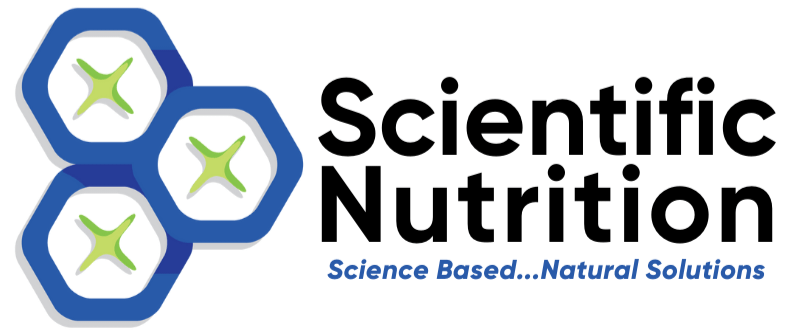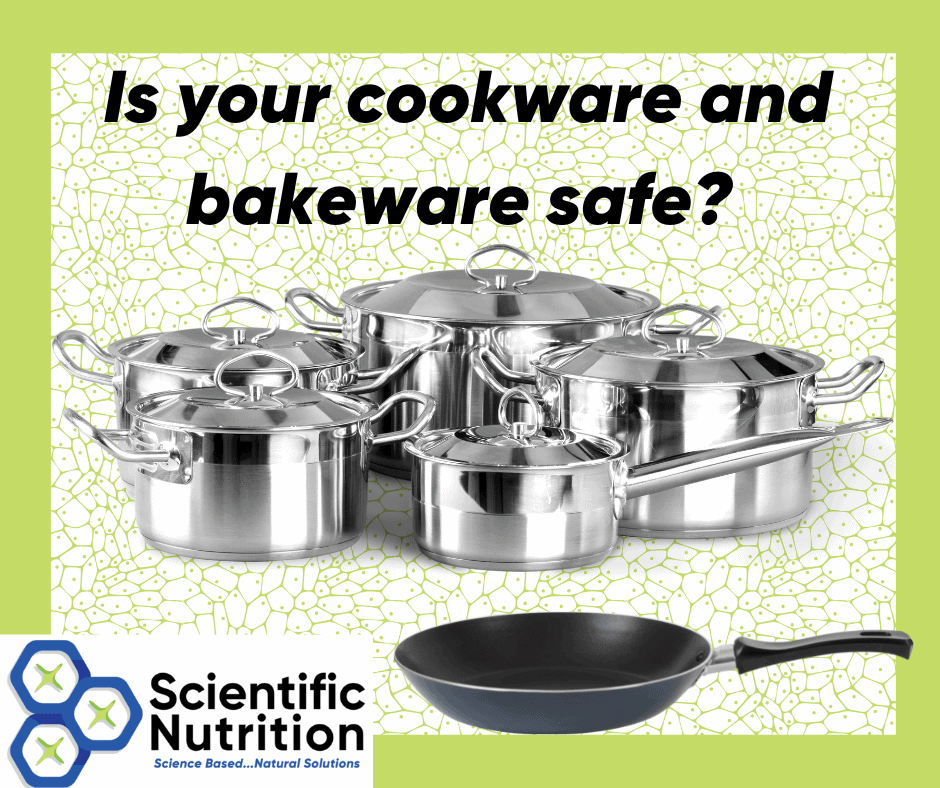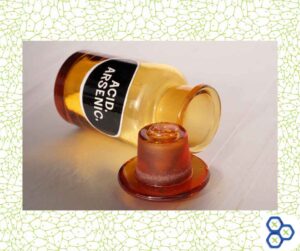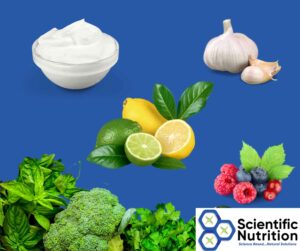Are my pots and pans the safest cookware for my health?
I get this question often as society becomes more aware of heavy metal toxicity sources. Using the safest cookware can stop a lot of toxins from entering your body daily. Many non-toxic brands of cookware that will last you a lifetime but many more that could be contributing toward your heavy metal load.
The main culprits found in “stainless steel” are Chromium, Nickel, Lead, Cadmium, and Aluminum. The alloys are made to make the cookware more durable or cheaper to make.
How can I test my cookware for safety?
First, look to see if a magnet sticks. In general, if it sticks it is safe and contains no nickel or alloy metals. The outside isn’t as important as your cooking surface, this is where you want it to stick.
You can also boil 2 Tablespoons of white vinegar in the pot or pan and taste test it. If you taste anything metallic it may be an alloy-based product. I compare my sample to a glass with the same amount of vinegar to make sure they taste the same. If the acidity pulls metal-tasting water, find a new product.
What is austenitic stainless steel?
Austenitic steel is most often made of metal alloys such as Chromium and Nickel. Sometimes a pot or pan will be labeled as “18/8” indicating 18% Chromium and 8% Nickel.
The exception is if you have a cold worked grade austenitic stainless steel with the numbers 304 (SS304) or 316 (SS316) stamped on them. The 316 is also corrosion resistant as well as non-magnetic but a good choice. Either may be tested by seeing if a magnet sticks on the inside, this would be a good thing showing no nickel where food is cooked.
Avoid anything stamped with 31655 as it contains toxic molybdenum that can pull copper out of the body. As a result, you can become copper anemic.
What is Ferritic stainless steel?
It is a cost-effective but may contain chromium, molybdenum, or titanium to increase durability. They are magnetic due to a lower nickel content but I wouldn’t recommend them due to heavy metal contamination.
What is martensitic stainless steel?
It contains added carbon for making tempered or harder metal items such as razors, knives, or scissors. It does prove to be magnetic it may be safe from harmful metals.
What are the safest pots and pans to use?
For the safest cookware, there are two types I recommend.
1. Stainless steel.
Stainless steel needs to be at least 10.5% chromium and at the very most 1.2% carbon as well as iron (which makes it magnetic) to be labeled as stainless steel. They may contain nitrogen, silicon, and manganese as well so quality is very important.
I use Vital Nutrition by Diamondcraft cookware brand we purchased over 28 years ago. They have 5 to 7-ply surgical stainless steel with an oil core for water-less cooking. Boiling your food, you’ll lose 30-50% of vitamins and nutrients, compared with 2-5% with Diamondcraft.
They are handcrafted in the USA and still look new after cooking for my family of 6 with them for over a quarter of a century. The investment was well worth it as they have a lifetime warranty and have replaced a lid steamer for free (as I wore it out).
Stainless made in other countries may not have the same standards and may release low levels of Nickel and Chromium. This is especially true if you are cooking acidic foods such as tomato-based sauces.
Another great brand is All-Clad Stainless then Calphalon Tri-ply. Ensure you are investing in the best quality to last a lifetime. You will not only save time replacing lesser quality products, you will not sacrifice your health!
2. Ceramic cookware.
Ceramic kiln-baked quartz or sand surfaces are best. Items that are coated with nonstick coating contain titanium dioxide. This toxin can damage sperm, affect male fertility, and damage the liver, testicles, heart, brain, and kidneys. It also alters the gut microbiome and is rightly banned in France. Avoiding glazed products is highly recommended as they may contain heavy metals such as lead.
Most recently Skittles candy has been in trouble with the Food and Drug Administration for toxin amounts of titanium dioxide.
Xtrema Cookware is a great 3rd party tested brand that ensures there is no harmful lead, cadmium, or other heavy metals to leach out. They don’t use glues, dyes, polymers, or coating. Other brands use harmful coatings or glaze so use extreme caution. This product is an example of a kiln-baked surface.
The original Greenpan has an Aluminum coating under the ceramic and the added benefits of no lead, cadmium, PFAs, or PFOAs which I’ll break down further in this article. This is a good quality pan that will last for many years.
Which bakeware is safest?
Using pyrex-type glass dishes, stoneware that is tested for heavy metals, or surgical-grade stainless steel bakeware that is nickel free are your best choices. Using non-bleached parchment paper between the food and bakeware is an added protection from leaching.
I’m not 100% sure that silicone baking dishes are safe as far as chemical contamination so until further studies are done, I would avoid them.
Which chemicals can be found in cookware?
The safest cookware will not contain chemicals that are released while cooking at medium to high heat. Two of the most dangerous and common ones can be eliminated by choosing better pots and pans.
PFAs are man-made chemicals found in the air, water, and soil. Most commonly these chemical toxins have been found in 97% of Americans! The issues that may occur from frequent exposure are fertility, low growth, slower metabolism, obesity, suppressed immune system, and increased risks of cancers.
PFOAs are life-long retained chemicals that affect our reproduction, liver health, and children’s growth and development. It is primarily found in Teflon-coated cookware and has been found globally in the blood of most mammals (even whales). Boiling water will not remove it but using a good water filter such as Berkey or ZeroWater’s 5-stage filter will cut the amount significantly.
Which heavy metals can be found in cookware?
Lead toxicity can cause abnormal brain function, blindness, convulsions, deafness, dyslexia, encephalitis, epilepsy, insomnia, multiple sclerosis, muscular dystrophy, Parkinson’s disease, vertigo, arteriosclerosis, atherosclerosis, colic, constipation, weight loss, spontaneous abortions, infertility, hypothyroidism, cancer, diabetes, hypoglycemia, anxiety, poor concentration, mood swings, nightmares, psychotic behavior, and alopecia.
Cadmium toxicity can cause tends to harden and inflame the arteries leading to arteriosclerosis, atherosclerosis, impaired circulation, hypertension, heart failure, cancer, hypoglycemia, diabetes, mental illness, bone pain, osteoporosis, tendon problems, damages to all body organs, loss of sense of taste, wound healing delayed, migraine headaches, psoriasis, kidney failure.
Nickel toxicity can cause kidney dysfunction, heart attack, oral cancer, intestinal cancer, skin problems, nausea, vomiting, hemorrhages, malaise, low blood pressure, muscle tremors, tetany, and paralysis. Nickel affects the mind and emotions deeply. It is also associated with fears, anger, depression, and suicidal thoughts.
Aluminum toxicity can trigger flatulence, headaches, dryness of skin and mucous membranes, tendencies for burning pain in the head relieved by food, loss of memory and mental confusion, some dementias, and reduced sweating. Later symptoms include Alzheimer’s disease, other dementias, amyotrophic sclerosis, anemia, colitis, dental cavities, kidney and liver dysfunction, neuromuscular disorders, and Parkinson’s disease. Avoid aluminum cookware for all of these reasons as well.
Learn more about heavy metal toxicity HERE.
Tips for safer cooking:
- Use silicone or wooden utensils to avoid scratching pots or pans and exposing any underlayers. You’ve stepped up to using the safest cookware so this is the next step. By ditching plastic utensils you can avoid releasing hormone-disrupting chemicals while keeping your cookware nice.
- Soak your rice overnight in a 2:1 spring water bath to reduce the arsenic levels by up to 80% before cooking. If you are in a pinch, use a 5:1 ratio of water to rice then rinse after dumping excess water after cooking to cut the arsenic levels in half.
Are you ready to improve your health?
Let’s Chat about your goals!
Learn about seeing where your heavy metal toxicity levels are and how to remove them through Hair Analysis.
Copyright Scientific Nutrition, LLC 2023




